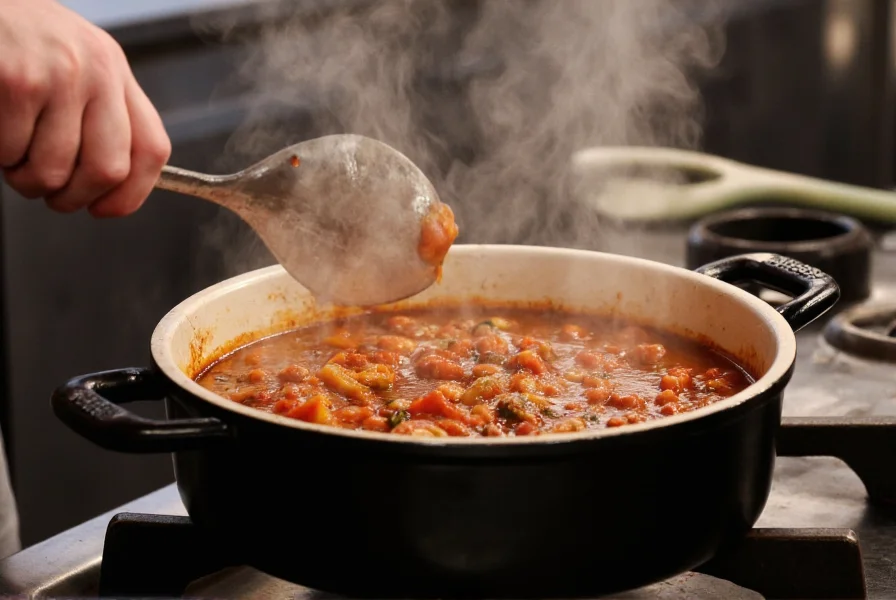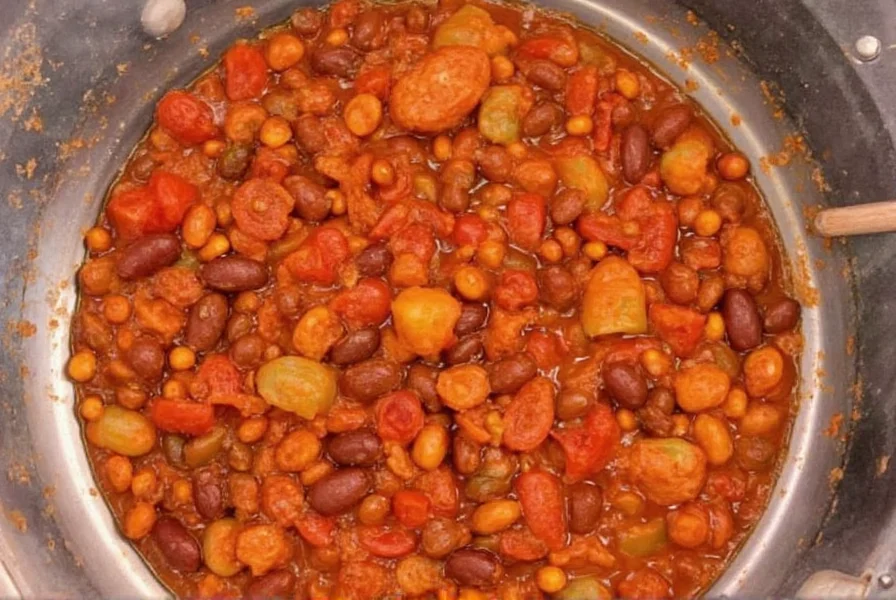Understanding precisely how long to cook chili separates a mediocre bowl from an exceptional one. While many beginners assume chili simply needs to heat through, proper cooking time transforms ingredients into a harmonious, deeply flavored dish. Let's explore the factors that determine optimal chili cooking duration across various preparation methods.
Factors That Determine Chili Cooking Time
The question how long to cook chili doesn't have a single answer. Several variables affect the ideal simmering duration:
- Meat type and cut - Tougher cuts like chuck roast need longer to break down than ground beef
- Cooking vessel - Different equipment transfers heat differently
- Recipe complexity - Bean-based vs meat-heavy vs vegetarian variations
- Desired consistency - Thick stew-like vs brothy chili
- Flavor development - Longer cooking melds flavors but risks overcooking certain ingredients
| Cooking Method | Minimum Time | Optimal Time | Maximum Recommended |
|---|---|---|---|
| Stovetop | 45 minutes | 1.5-2 hours | 3 hours |
| Slow Cooker | 4 hours (high) | 6-8 hours (low) | 10 hours |
| Instant Pot | 15 minutes | 20-25 minutes | 30 minutes |
| Oven | 1 hour | 2-2.5 hours | 4 hours |
Stovetop Chili: The Traditional Approach
When cooking chili on the stovetop, the minimum time to cook chili properly is 45 minutes, but this only heats ingredients through without proper flavor development. For authentic results, plan for 1.5 to 2 hours of gentle simmering after bringing to a boil.
During the first 30 minutes, ingredients release their individual flavors. The next 60-90 minutes allow those flavors to meld while tougher meat cuts become tender. Stir occasionally and maintain a gentle simmer - boiling too vigorously can break down tomatoes too much and create a watery texture.

Slow Cooker Chili: Set It and Forget It
Many home cooks wonder how long to cook chili in a slow cooker for best results. The magic happens with low-and-slow cooking:
- High setting: 4 hours (minimum), but flavors won't fully develop
- Low setting: 6-8 hours (optimal for flavor integration)
- Maximum time: Don't exceed 10 hours or beans may disintegrate
For food safety, ensure your slow cooker reaches 140°F within the first few hours. If adding dairy or delicate ingredients like avocado, incorporate them during the last 30 minutes to prevent curdling or overcooking.
Instant Pot Chili: Fast but Flavorful
The question how long to cook chili in Instant Pot has a precise answer: 20-25 minutes at high pressure yields perfectly cooked chili with developed flavors. Here's the breakdown:
- Sauté ingredients: 5-7 minutes
- Pressure cooking time: 15 minutes
- Natural pressure release: 10-15 minutes
- Final simmer: 5 minutes to adjust consistency
While significantly faster than traditional methods, the pressure cooking process actually enhances flavor extraction from spices and meat. Many chili enthusiasts find Instant Pot results rival stovetop versions when following proper timing.
How to Tell When Your Chili Is Perfectly Cooked
Regardless of cooking method, these signs indicate your chili has reached ideal doneness:
- Meat test: Shreds easily with a fork (for chuck roast) or is crumbly (for ground beef)
- Bean texture: Tender but still holding shape (if using beans)
- Sauce consistency: Coats the back of a spoon without being watery
- Flavor balance: Individual ingredients aren't distinguishable; flavors have melded
- Surface sheen: A thin layer of oil appears on the surface, indicating proper reduction
Remember that chili continues to develop flavor as it rests. Always allow at least 15-20 minutes of resting time before serving to let flavors settle and ingredients absorb the sauce.
Common Chili Cooking Mistakes and Solutions
Many home cooks make these timing-related errors when preparing chili:
- Undercooking: Results in raw spice flavors and tough meat - solution: extend cooking time by 30-45 minutes
- Over-reducing: Makes chili too thick - solution: add broth or tomato juice, ¼ cup at a time
- Adding tomatoes too early: Can make meat tough - solution: add acidic ingredients after meat has browned
- Not allowing resting time: Flavors remain separate - solution: always let chili rest 15+ minutes off heat
For the best time to cook chili for flavor development, consider making it a day ahead. Refrigeration allows flavors to continue melding, often improving taste significantly by the next day.
Storage and Reheating Guidelines
Properly cooked chili stores well, but timing affects how it reheats:
- Cool completely within 2 hours of cooking
- Store in airtight containers for up to 4 days in refrigerator
- Freeze for up to 6 months (flavor may degrade after 3 months)
- Reheat gently on stovetop, adding liquid if needed
When reheating, bring chili to 165°F throughout. The second day often yields better flavor as ingredients continue to absorb the sauce, but don't reheat more than twice for food safety.
Can you overcook chili on the stove?
Yes, cooking chili longer than 3 hours on the stovetop can cause ingredients to break down excessively. Beans may disintegrate, tomatoes can become overly acidic, and meat might turn mushy. The optimal stovetop cooking time is 1.5-2 hours for most recipes, followed by a 15-20 minute resting period before serving.
Does chili taste better the longer it cooks?
Chili flavor improves with cooking time up to a point. The first 90 minutes develop foundational flavors, but beyond 3 hours on the stovetop, ingredients can degrade. Many chefs recommend making chili a day ahead, as refrigeration allows flavors to meld without overcooking. The ideal approach is to cook for 1.5-2 hours, then let it rest overnight for maximum flavor development.
How long should chili simmer before serving?
Chili should simmer for a minimum of 45 minutes to allow flavors to combine, but 1.5-2 hours produces significantly better results. After reaching your desired cooking time, remove chili from heat and let it rest for 15-20 minutes before serving. This resting period allows flavors to settle and ingredients to absorb the sauce, creating a more cohesive final product.
Why does my chili taste better the next day?
Chili often tastes better the next day because the resting period allows flavors to continue melding through a process called flavor integration. As the chili cools and sits, starches from beans and grains absorb liquid, spices distribute more evenly, and complex flavor compounds develop. This chemical process continues even when refrigerated, resulting in a more balanced, rounded flavor profile by the second day.











 浙公网安备
33010002000092号
浙公网安备
33010002000092号 浙B2-20120091-4
浙B2-20120091-4